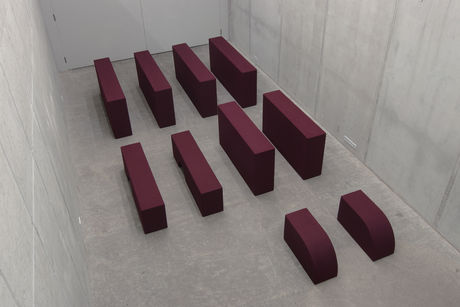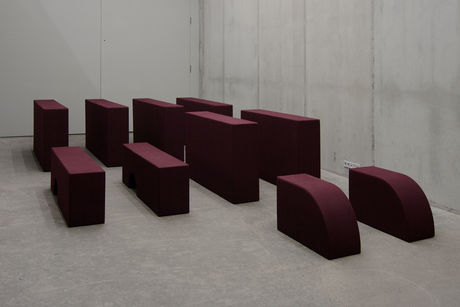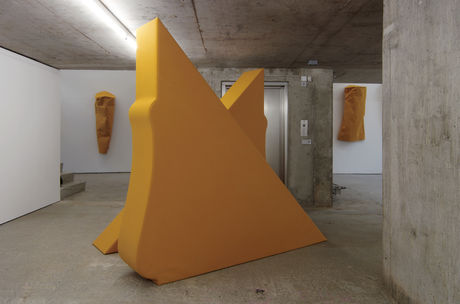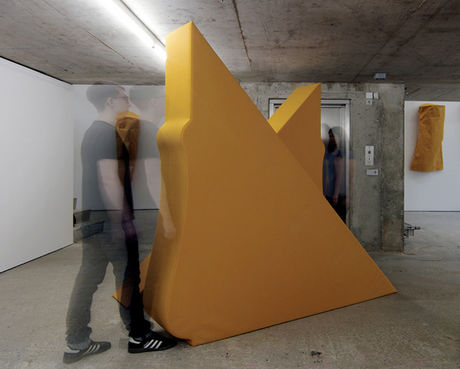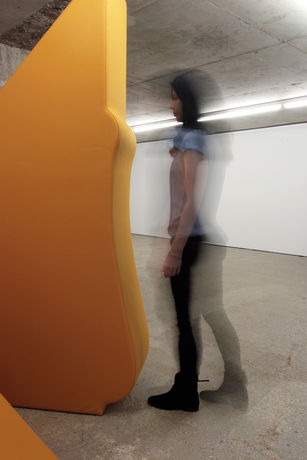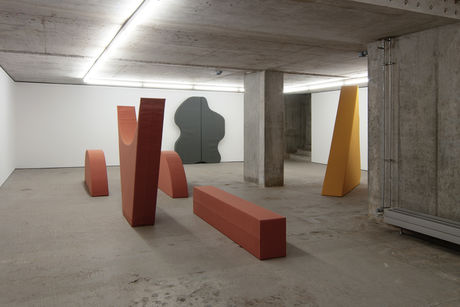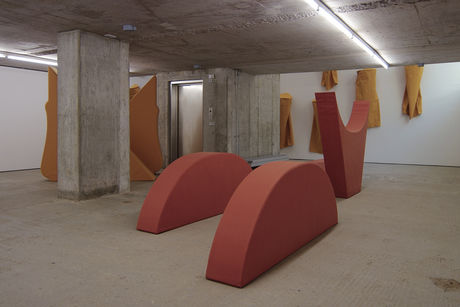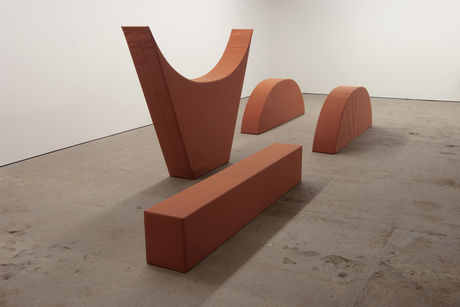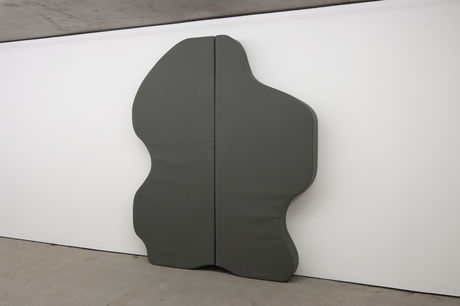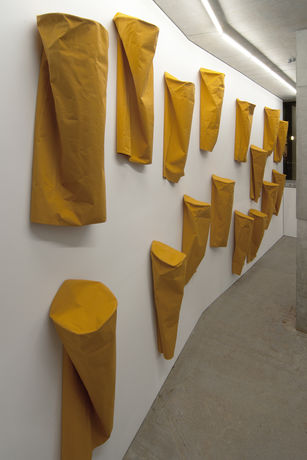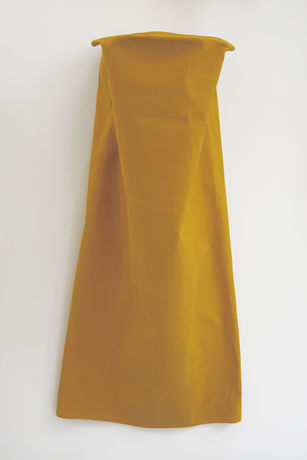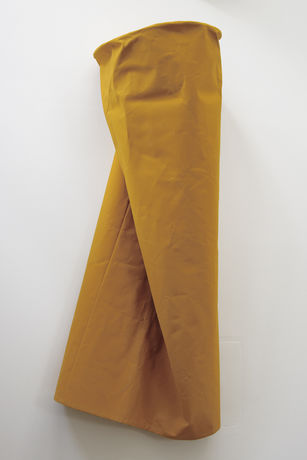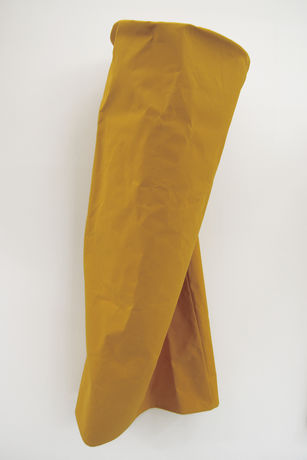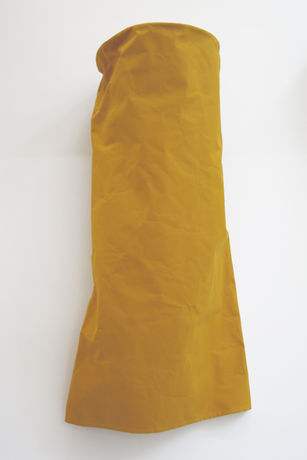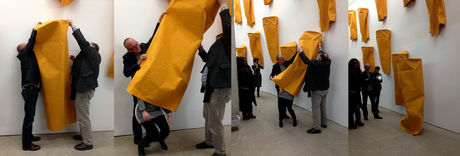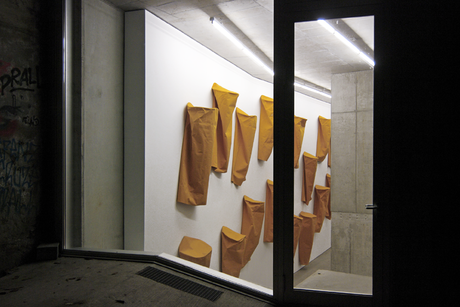Franz Erhard Walther
Körperformen / Body Shapes
Nov 30, 2013–Feb 13, 2014
Nov 30, 2013–Feb 13, 2014
In the past few years, Franz Erhard Walther (born 1939) has created a new set of works he calls Körperformen (Body Shapes). With the maturity of the artist’s late œuvre, these multipart sculptures made of foam material and upholstered in colorful fabrics recapitulate what has been the defining quality of Walther’s art for more than five decades: The “escape from the picture”; the dissolution of a static conception of the work in favor of a dynamic interrelation between things, persons, and the space they share. Starting in 1962, Walther became a pioneer of both participatory and minimalist forms in art by setting objects, sometimes manufactured in series, that invited hands-on application and championed the idea of active intervention on the part of the viewer-cum-user. He conceived a relational aesthetics avant la lettre. “Virtually no artist,” the ZKM | Center for Art and Media Karlsruhe recently noted, “changed the definition of what sculpture can be as early, or to as lasting effect, as he did.”
“Sculpture doesn’t need the eye,” Walther writes with programmatic hyperbole in a note on a sketch made in 1966/69. His work is addressed not (only) to the gaze, but to the whole body, with all its senses and capacity for social interaction. His Vier Körperformen (Four Body Shapes, 1963), for example, are textile objects in organic cuts that may be held to different parts of the body, alone or together with others. In the 1970s, his installations take on architectural dimensions: corners, niches, and pathways offer viewpoints the audience can adopt, stepping into the sculptures and becoming part of them. Among the works Walther creates in the 1990s are the Konfigurationen (Configurations), abstract compositions whose proportions always remain related to the body, the space surrounding it, and the tactile qualities of the fabrics.
These and other strands in Walther’s œuvre resurface in the Körperformen, some of which are on display for the first time in the current exhibition at KOW. It is striking to see how playfully this influencial “Participatory Minimalist” (who has moved back to his native Fulda) conceives his objects. With their generously tailored outlines, sturdy volumes, and clear colors, the instrumental sculptures resemble a larger-than-life building-block set to be stacked up in the mind like a towering puzzle. Each work comes in several parts that may be combined to create a large self-contained shape. Some have curved surfaces designed to accommodate the human body. The Körperformen mediate between architecture, object, and human being, setting them in interrelation and lending them proportion.
Our exhibition, designed in collaboration with Franz Erhard Walther, also looks back on one of his most extensive wall installations from the early 1980s—the 24 Gelbe Säulen (24 Yellow Columns, 1982) is an ensemble of head-high cylindrical shapes in yellow muslin covers that has never been shown to the public. The antique-like motif is not a coincidence. From the beginning of his career, Walther sought to define an aesthetic that would dodge the challenges of shifting tastes as far as possible—that would, in its palette, materiality, and formal evolution, reach for the timeless or perhaps the untimely. This quest is the source of the quiet seriousness of Walther’s œuvre, which has nonetheless remained playful throughout the past 50 years. What’s more, it animates our ludic drives and solicits the involvement of an imagination perpetually spurred by an open conception of the work to exercise its agility.
Text: Alexander Koch
Translation: Gerrit Jackson, Kimberly Bradley
Photos: Alexander Koch
“Sculpture doesn’t need the eye,” Walther writes with programmatic hyperbole in a note on a sketch made in 1966/69. His work is addressed not (only) to the gaze, but to the whole body, with all its senses and capacity for social interaction. His Vier Körperformen (Four Body Shapes, 1963), for example, are textile objects in organic cuts that may be held to different parts of the body, alone or together with others. In the 1970s, his installations take on architectural dimensions: corners, niches, and pathways offer viewpoints the audience can adopt, stepping into the sculptures and becoming part of them. Among the works Walther creates in the 1990s are the Konfigurationen (Configurations), abstract compositions whose proportions always remain related to the body, the space surrounding it, and the tactile qualities of the fabrics.
These and other strands in Walther’s œuvre resurface in the Körperformen, some of which are on display for the first time in the current exhibition at KOW. It is striking to see how playfully this influencial “Participatory Minimalist” (who has moved back to his native Fulda) conceives his objects. With their generously tailored outlines, sturdy volumes, and clear colors, the instrumental sculptures resemble a larger-than-life building-block set to be stacked up in the mind like a towering puzzle. Each work comes in several parts that may be combined to create a large self-contained shape. Some have curved surfaces designed to accommodate the human body. The Körperformen mediate between architecture, object, and human being, setting them in interrelation and lending them proportion.
Our exhibition, designed in collaboration with Franz Erhard Walther, also looks back on one of his most extensive wall installations from the early 1980s—the 24 Gelbe Säulen (24 Yellow Columns, 1982) is an ensemble of head-high cylindrical shapes in yellow muslin covers that has never been shown to the public. The antique-like motif is not a coincidence. From the beginning of his career, Walther sought to define an aesthetic that would dodge the challenges of shifting tastes as far as possible—that would, in its palette, materiality, and formal evolution, reach for the timeless or perhaps the untimely. This quest is the source of the quiet seriousness of Walther’s œuvre, which has nonetheless remained playful throughout the past 50 years. What’s more, it animates our ludic drives and solicits the involvement of an imagination perpetually spurred by an open conception of the work to exercise its agility.
Text: Alexander Koch
Translation: Gerrit Jackson, Kimberly Bradley
Photos: Alexander Koch
